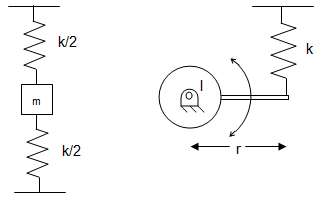Simple Harmonic Motion for Isolated Assembly

Description
This calculator assumes that the user has picked a candidate vibration isolator and wishes to verify its function with the assembly to be isolated. In the design of assemblies isolated from vibration, the isolator must be matched to the body in terms of natural or resonant frequency. More accurately, the natural frequencies must be MIS-matched, ideally by a factor greater than ?2. (The assembly's resonance should be approximately 40% greater --or more-- than the isolator resonance.) Often the natural frequency and spring rate of an isolator candidate is given by the manufacturer and the natural frequency of the system must be calculated. Assuming that the assembly is simple enough that it can be modeled as a lump mass (or rigid rotational body) in 'simple harmonic motion,' these equations will calculate the system's natural frequency.

Calculation Reference
Steinberg, Preventing Thermal Cycling and Vibration Failures in Electronic Equipment
Dynamics
Harmonic Motion
Vibration isolators are devices or materials used to reduce or eliminate the transmission of vibrations from one system to another. They can be essential in electronic equipment design to prevent the adverse effects of vibrations on components, performance, and reliability.
In the context of Steinberg's book, it is likely that he would discuss the following points related to vibration isolators:
-
Types of isolators: There are different types of vibration isolators, such as springs, rubber mounts, foam pads, and air mounts, each with their unique properties and applications. The choice of isolator depends on factors like the nature of the vibrations, frequency range, and the load-bearing requirements of the electronic equipment.
-
Selection criteria: When selecting a vibration isolator, it is crucial to consider its natural frequency, damping characteristics, and isolation efficiency. These factors determine the effectiveness of the isolator in reducing the vibration transmission to the electronic equipment. Additionally, the isolator's load capacity, size, temperature range, and environmental resistance should be considered.
-
Isolation effectiveness: The effectiveness of a vibration isolator depends on its ability to reduce the transmission of vibrations over a range of frequencies. The performance of an isolator is typically represented by its transmissibility, which is the ratio of the output vibration amplitude to the input vibration amplitude. The goal is to select an isolator with low transmissibility for the frequencies of interest.
-
Placement and installation: The proper placement and installation of vibration isolators are critical for their effectiveness. Isolators should be installed at strategic locations, such as the mounting points of electronic components or assemblies, to minimize the transmission of vibrations. Proper installation also involves ensuring that the isolators are not overloaded or underloaded, which can compromise their performance.
In summary, Steinberg's book is expected to cover the importance of vibration isolators in protecting electronic equipment from the detrimental effects of vibrations. It would likely discuss the types, selection criteria, isolation effectiveness, and proper installation of isolators to ensure the reliability and longevity of electronic systems.
Calculation Preview
Full download access to any calculation is available to users with a paid or awarded subscription (XLC Pro).
Subscriptions are free to contributors to the site, alternatively they can be purchased.
Click here for information on subscriptions.

